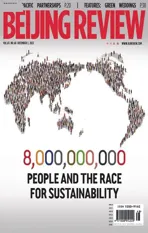A Test for the Asia-Pacific Community
2022-12-26ByOngTeeKeat
By Ong Tee Keat
The 2022 Asia-Pacific Economic Cooperation (APEC) Economic Leaders’ Meeting took place in Bangkok, Thailand, on November 18-19 against a backdrop of rising geopolitical rivalry. Themed Open, Connect, Balance, the event set priorities for responding to food and energy insecurity, climate change, inflationary pressure and the dire need for postpandemic economic recovery. Facilitation of trade and investment, restoration of connectivity, promotion of inclusive and sustainable growth through the Bio-Circular-Green economy constituted the three main thrusts of the agenda for this year.
Indeed, at this juncture, APEC’s designed aim of creating greater prosperity for the 2.9 billion people in the region by promoting balanced, inclusive, sustainable, innovative and secure growth through regional economic integration remains a real challenge. This was particularly so in the face of such headwinds as escalating deglobalization, disrupted connectivity and worsening carbon emissions worldwide.
The Putrajaya Vision 2040, adopted by APEC leaders in 2020, lays out the roadmap to guide member economies toward an open,dynamic, resilient and peaceful Asia-Pacific over the next two decades. Its three economic drivers, namely trade and investment; innovation and digitalization; and strong, balanced,secure, sustainable and inclusive growth; are the identified tools from APEC’s toolbox. But these will only gain traction so long as APEC remains guided by open regionalism and the principles of diversity and non-discrimination.
In this context, the Asia-Pacific community with a shared future proposed by Chinese President Xi Jinping is no doubt an ideal platform that fulfills current needs for multi-dimensional regional collaboration. This resonates well with the Global Development Initiative that Xi proposed at the General Debate of the 76th Session of the United Nations General Assembly in 2021. The initiative has since been well heeded as a timely proposition that can help boost the implementation of the 2030 UN Sustainable Development Agenda. Inclusive and egalitarian development in all respects is now pervasively reckoned as the solution to the prevailing trust deficit and economic disparity.
In his address titled Shouldering Responsibility and Working Together in Solidarity to Build an Asia-Pacific Community With a Shared Future to the meeting on November 18, Xi outlined the significance of staying committed to openness and inclusiveness in bringing about prosperity for all in the Asia-Pacific. He envisioned the shared destiny of the region where peace and stability could only be built through upholding international fairness and justice.This is consistent with the Global Security Initiative Xi proposed in April to promote the vision of common, comprehensive, cooperative and sustainable security.In this regard, an Asia-Pacific security architecture is necessary to create conducive conditions for ensuring economic development and durable peace and stability in the region.
While the Regional Comprehensive Economic Partnership signed between Association of Southeast Asian Nations countries, China, Japan, the Republic of Korea,Australia and New Zealand serves as a good template for APEC to emulate in regional economic integration, the proposed Asia-Pacific community with a shared future is a regional vehicle that embodies the essence of both the Global Development Initiative and Global Security Initiative.
Still possessing all the competitive edges that once created the Asia-Pacific miracle,the region should be resilient enough to make a strong comeback by leveraging digitalization and innovation, in addition to its conventional strengths, after the pandemic.
The Global Development Initiative rooted in the spirit of prosper-thy-neighbor is certainly relevant in the pursuit of common prosperity in the region. Only when the stakeholder nations are cognizant of their interests intertwined with more economic gains coming in, could we ever prudently anticipate seeds of peace being sown in a region with such diverse interests.
The APEC region produces 62 percent of global GDP and conducts 48 percent of global trade. It is now the promising prime mover of global economic recovery in the post-COVID era. Nonetheless, the Asia-Pacific can ill afford to be any major power’s backyard. Much less be the powder keg as the rivalry looms large. Neither should APEC be reduced to a mere pawn serving the interest of any single power as it will only put the future of the region at stake. BR
